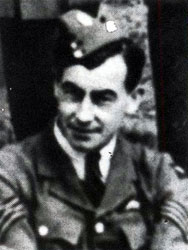Blenheim L8698 at Driffield airfield, damaged in air by enemy aircraft.
On 15th August 1940 many Luftwaffe aircraft were detailed to bomb Driffield airfield, the approaching bomber
force was picked up on the Chain Home detection system and many Allied fighter units were scrambled to intercept
them. This 219 Squadron aircraft is recorded as intercepting a "Heinkel HeIII" off the Yorkshire Coast and was damaged by returning
fire from the Heinkel off Scarborough at 14.00hrs, these strikes broke the front windscreen and injured the pilot in the arm. The air gunner was
able to take control of the aircraft and aim the aircraft towards land, where he landed wheels-up at a bomb crater-riddled Driffield airfield. A
number of the German aircraft are believed to have been damaged and some crashed into
the sea while others were shot down over land and are detailed on this website accordingly. Both airmen flying
Blenheim L8698 were awarded DFM's for their actions on this day.
The citation for their awards was a joint one, they were the first awards to aircrew of 219 Squadron. The citation
reads.. "Sgt Dupee and Sgt Banister were the pilot and
air gunner respectively in an aircraft which attacked a Heinkel 111K. Shortly after commencing
the attack the return fire from the enemy aircraft ceased, but as Sgt Dupee was about to
continue his attack at short range the Heinkel's dorsal gun again opened fire, severely wounding
him in the arm and causing damage to his aircraft. Sgt. Banister thereupon crawled forward,
assisted Sgt Dupee from his seat, and took control of the aircraft. Despite failing strength
through loss of blood, Sgt Dupee gave directions to Sgt Banister, who, although untrained as
a pilot, was enabled to fly the aircraft until compelled to force land. This was carried out
on a strange aerodrome with the undercarriage retracted, and only slight damage was caused
to the aircraft."
There is a puzzle with the attacking aircraft being indentified as a Heinkel.
The attacking Luftwaffe force heading to Driffield was made up of Junkers Ju88 aircraft and not
Heinkel HeIII's but the Heinkel HeIII's were tasked with bombing Dishforth and Linton on Ouse
and a major navigation error sent all these aircraft some seventy miles too far north. None made
it through to their primary targets as they were intercepted by aircraft from a number of Spitfire
and Hurricane Squadrons including 41 Squadron, based at Catterick. This Blenheim belonged to 219
Squadron, also based at Catterick so some may well have been scrambled to intercept the same
aircraft but Spitfires flew much faster than Blenheims so if this Blenheim went to the same area it either
must have arrived much later than the Spitfires or had chased them many miles out to sea. The Blenheim was attacked off Scarborough and the
Heinkel's are not thought to have made it that far south. Had the Blenheim been damaged by a Heinkel it must have flown many miles off course and
crossed the coast much further south than predicted. The more logical explanation would
be that 219 Squadron were scrambled to the Bridlington area (which thirteen aircraft were)
and it was infact damaged by a Junkers Ju88 and in the confusion of battle the Blenheim crew
mis-identified the aircraft.
Pilot - Sgt Oswald Arthur Dupee RAFVR (700102). Injured by enemy action.
Air Gunner - Sgt Thomas Henry Banister RAF (517215).
Oswald Dupee was born in the Barnet district of Middlesex in 1916, he joined the RAF Reserve in 1934 and was called up in September 1939. He received his commission to P/O on
probation (emergency) on 9th May 1942 and on 9th November 1942 he rose to F/O on probation (war subs). F/O Oswald Dupee (123298) was later awarded the DFC for service with 684
Squadron flying Mosquitoes in the Far East, Gazetted on 21st January 1944. His citation for the award was a joint one with his then observer and reads.. "these officers, as
pilot and observer respectively, have completed several long distance reconnaissance missions and have obtained excellent results. They have set a fine example of skill,
determination and devotion to duty". He rose to F/Lt (war subs) on 9th May 1944 and having survived the War he remained in the air force, transferring to the Technical Branch in March 1949 and rising to S/Ldr on 1st January 1956. In 1968 he joined the Engineering Staff at Strike Command but died only a year later in Greenwich, London.

Thomas Banister joined the RAF in April 1934 but later re-trained as an air gunner. He received his commission on 20th March 1942 and was granted the rank of P/O on probation
(emergency) and rose F/O on probation (war subs) on 1st October 1942 and then to F/Lt (war subs) on 20th March 1944.
Blenheim L8698 was built to contract 551920/37 by Rootes Securities Ltd. at Speke and was
awaiting collection in July 1939. After a period of MU storage it was taken on charge by 219 Squadron
at Catterck on 4th October 1939 when the unit reformed. In the incident detailed above on 15th
August 1940 Cat.R/FB damage was recorded. The damage was apparently repaired on site
in the bomb-damaged Driffield airfield by a team from The Bristol Aeroplane Co. Ltd. and returned to Catterick
just as 219 Squadron were being transferred to Redhill in October 1940 so it was taken on charge by 600 Squadron
who moved into Catterick on 12th October 1940. In February 1941 600 Squadron ceased operating Blenheim MkIf's
so the aircraft was flown into MU storage. Its record from this point becomes unclear but it was at some
point taken on charge by the RAFC at Cranwell and its only record after that is that it crashed on 3rd October
1944 and sustained Cat.E damage but no details are known or where the crash occurred.